Sonic Impressions
Young DO (that's Daniel) settled onto the sofa next to me for what was really his first exposure to the Quests. He liked them immediately, and in a big way: "Better than the Sound-Labs!" he quipped, referring to the Sound-Lab A-1s that had recently vacated the reference room.
What a first impression! Was this true? Were the Quests, at a third the price, indeed superior to the A-1s? That observation stuck in the back of my mind, and for the next several weeks I digested its significance. You know, young DO was right—in some respects the Quests were better than the A-1s.
We were listening to Harry Belafonte (Belafonte at Carnegie Hall, RCA 6006-2-R), and it was clear that while the width and depth of the soundstage were well-portrayed, the soundstage opened up more than it did with the A-1s. The impression of hall decay and low-level detail was clearer. It was easier to immerse oneself in the acoustic of Carnegie Hall via the Quests. We both found it easier to transport ourselves into the original space and mood of the event. We laughed at and applauded Harry's infectious humor.
Eric Clapton's Unplugged (Reprise 45024-2) was another example where the magic of the moment and the honesty of the music were communicated more effectively. Our feeling that the Quests offered heightened soundstage transparency remained constant throughout the evaluation period. The resolution of hall ambience was uniformly excellent, and, combined with a wealth of low-level detail, gave me the strong impression that I was peering at my favorite records through a high-powered microscope.
These differences in transparency and resolution between the two speakers very likely had a lot to do with the room itself. The A-1s, being such large planar radiators, involve more of the room simply because their rear-radiation pattern is harder to break up, at least in smaller rooms. So they yield a stronger reflected-sound signature that obscures some of the original ambient information and fine detail.
In common with other planar speakers, the Quest eclipsed box speakers in the portrayal of image size. In my experience, painting a convincing illusion of instrumental outlines with concert-hall realism is best accomplished with planars. The pinpoint localization sought by many minimonitor aficionados is an artifact that doesn't exist in the concert hall, and I find it distracting. The end result is akin to watching a bunch of tiny people crowding onto a stage with toy-sized musical instruments.
The basic problem with box speakers is, I believe, their inherent inability to reproduce musical instruments with the proper surface loudness. Practically speaking, there's no such thing as a point source of sound. Every musical instrument has a sounding board or body which contributes sound power. A piano, for example, puts out a lot of power, but it radiates over a large area. Surface loudness is defined as the ratio of sound power to surface area, and would appear to be responsible, at least in part, for the impression of size. Because a planar has a large radiating area, it can duplicate the surface loudness typical of a piano. A typical box speaker, however, has to squeeze the piano through an 8" cone. The fit is poor and the resultant surface loudness is all wrong.
Through the Quests, the spatial impression of a singer standing in front of me—or the proportions of a piano occupying real estate within the soundstage—were extremely believable, surpassing, in this respect, all box speakers I have heard.
Just as important was the Quest's ability to maintain a realistic image size over the entire spectral range of an instrument. Many box speakers cross over from a 6"–8" cone to a 1" tweeter in the low treble. In the crossover region, the woofer/midrange output is beaming like a flashlight (because the diaphragm size is approaching the wavelength the unit is reproducing), while the tweeter exhibits wide dispersion. These differences in dispersion appear to contract and expand the image size as the instrument's overtone structure moves through this region. Because the Quest speaks with one voice through the midrange and treble, and because dispersion is controlled by its curvilinear panel, image size remains stable with frequency.
The Quest proved capable of fleshing out dynamic contrasts from soft to loud, and from loud to very loud. Of course, this ability depended strongly on the front-end and partnering amp. Every improvement in the front-end was clearly revealed by the Quest. In no way was it the weak link in the chain. As the dynamics of the front-end improved, the Quest was able to keep up. It proved to be of reference quality in its ability to readily resolve preamp and cartridge differences. Not only was the delicate bloom of harmonic textures preserved, but the force and impact of a loud-to-very-loud crescendo were left undiminished. It was possible to cleanly reach peaks in excess of 100dB at the listening seat. (The amplifier had to be capable of delivering at least 100W into a 4 ohm load; otherwise it simply ran out of steam and clipped.)
In terms of tonal balance, the Quest was not entirely accurate. The extreme treble was extended and transients were delineated effortlessly and cleanly. But in the mid-treble—from about 3kHz upward—the sound was a bit laid-back and too polite. The effect was natural, in the sense that it would be a balance one would experience from the rear of a concert hall. While it wasn't something that bothered me, it was noticeable. The upper registers of female voice lacked brilliance. Trumpet (eg, Baroque Duet with Kathleen Battle and Wynton Marsalis, Sony SK 46672) sounded a bit too rounded and lacked proper bite.
More serious was the paucity of weight in the upper bass, in the octave from about 80–160Hz. This was most evident in the reproduction of double bass. The harmonic content of the instrument's lower registers is quite high, but the Quest failed to fully flesh out the body and weight of the double bass. Rather than sounding full and intimidating, a closely miked double bass sounded as if it had gone on a diet. Mind you, I'm not complaining about the deep bass, or even the midbass. The Quest sounded subjectively flat to about 30Hz in my listening room. And with the right amp, the quality of the lower octaves was quite detailed and defined. It was just that there was not enough output through the upper bass, which slighted any music with a strong bass foundation. The Quest routinely sounded lean with orchestral music and jazz, and was no match in this respect for the opulent-sounding A-1.
Amplifier choices
Over a period of several months, I used the Quests with amplifiers as different in design as the Fourier Components Sans Pareil OTL and the Classé 700 monoblocks. This speaker showed a remarkable degree of latitude in accommodating all comers. The best traits of each amp were highlighted. It was not very fussy, except in the areas of power output and bass definition. Tubed amps, in general, excelled in re-creating a palpable soundstage, but failed to exercise tight control over the bottom octaves. Considering the lean balance of the speaker, it's hardly permissible to sacrifice bass control. The best bass performance by a tubed amp was turned in by the Jadis JA-200. The solid-state Classé 700s did a fabulous job in tightening up the bass and effortlessly revving the Quest to full volume. Of course, if you're extravagant enough, you might want to consider bi-amping with tubes on top and transistors on the bottom.
Summing up
The MartinLogan Quest Z's midrange is absolutely world-class: as pure and transparent as anything out there. The upper octaves are well-integrated in character and speed with the mids, but even with the presence-contour switch in the +2dB position, I felt the highs to be a bit recessed.
The Quest's integration of the dynamic woofer with the panel is quite successful. The woofer doesn't intrude into the lower midrange (as it often does with hybrids, muddling hall ambience and low-level detail). However, I could have used quite a bit more upper bass.
But even with its not-altogether-accurate tonal character, I would like to make it known far and wide that I have intensely enjoyed this speaker. Everyone who heard the MartinLogan Quest Z in my reference room walked away impressed with its inherent musicality. This is one enjoyable speaker! It's bound to make a lot of friends. In its price range, it would be first on my shopping list. If you've never experienced the joys of a good planar speaker, here's your chance. M-L has made the transition from boxes to electrostatics as easy as possible. Now you can have your dynamic bass extension and impact, while tasting the formerly forbidden electrostatic fruit. Buckle yourself in and get ready to experience a new frontier of musical pleasure.
Sidebar 1: Specifications
Description: Hybrid loudspeaker system. Drive-units: 12" cone woofer in a sealed enclosure; electrostatic panel, 15" W by 44.5" H. Crossover frequency: 125Hz. Crossover slopes: second-order, 12dB/octave. Frequency response: 28Hz–22kHz, ±2dB. Presence control switch: +2dB, 1–5kHz. Bass control switch: –5dB, 60–150Hz. Nominal impedance: 8 ohms (minimum 2 ohms). Phase angle: less than 45 degrees. Sensitivity: 90dB/W/m (2.83V). Recommended amplifier power: 80–200Wpc.
Dimensions: 72.75" H by 19" W by 13" D. Weight: 125 lbs each.
Finishes available: light oak, dark oak, black; other custom-painted finishes are available to order.
Serial numbers of units tested: QEEA000/1-Z (bases), QSEA000/1 (panels).
Price: $3995/pair (custom finishes, $4500/pair) (1993); no longer available (2005). Approximate number of dealers: 65 (1993).
Manufacturer: MartinLogan Ltd., P.O. Box 707, Lawrence, KS 66044. Tel: (913) 749-0133. Fax: (913) 749-5320. Website: www.martinlogan.com
Sidebar 2: The Sonic Quest
Martin Colloms's discussion last year of some of the imponderable elements of loudspeaker reproduction (Stereophile, November 1992, Vol.15 No.11, p.76) reminded me of something written nearly a quarter-century ago (in Wireless World, November 1970) by metal-cone speaker pioneer Ted Jordan. Ted asked the rhetorical question: "What is the aim of a loudspeaker?" He then proceeded to examine a number of possible answers. The most objective answer possible, and one that would surely impress our engineering alter egos, was: to reproduce the electrical input signal as accurately as possible.
Jordan quickly rejected this definition on the following grounds: No loudspeaker is perfect, and all are subject to some degree of distortion, whether of frequency, transient, harmonic, intermodulation, phase, or waveform. However, it's often possible for the designer to trade an increase in one kind of distortion for a reduction in another. The true art of loudspeaker design resides in striking the proper balance. As we all know, that's not easy. The auditory system is much more sensitive to some kinds of distortion than to others, and sensitivity varies with the individual.
This paves the way for a subjective answer: that the aim of the loudspeaker is to reproduce the original sound as realistically as possible. In the final analysis, the illusion of "live" is what counts. Unfortunately, as Ted pointed out, many modern loudspeakers rarely allow the listener to escape from the fact that the sound is "canned." My first objective during the evaluation process is to determine whether the loudspeaker is able to cross that magical line to reconstruct a viable illusion of a live event.
The critical parameter here is emotional involvement with the power and drama of the music. Without a notepad in hand, and with my mind uncluttered (or at least in a semi-Zen-like state), does the loudspeaker elicit an emotional response? Am I tapping my foot in tune with the music? Am I forgetting tomorrow's chores? Or am I, instead, sufficiently underwhelmed that unrelated thoughts start creeping into my consciousness? After this initial phase comes the really hard part of having to analyze just why I was, or was not, swept away by the music.—Dick Olsher
Sidebar 3: Measurements
Despite the Z modification making the Quest easier to drive, it's still a demanding load for an amplifier, the impedance dropping to 2.7 ohms in the midbass and lower midrange and dropping below 2 ohms above 16kHz (fig.1). The minimum value is a punishing 1.4 ohms at 25kHz—fortunately, there is no high-level musical information up there. Note the moderate phase angle, however, which ameliorates matters. With the bass set to –5dB, the impedance does become a little kinder in the bass, staying above 4 ohms below 160Hz. The woofer tuning is revealed by the peak at 32Hz. The Quest's B-weighted sensitivity appeared to be in the region of 85dB/W/m, which is significantly lower than specified.
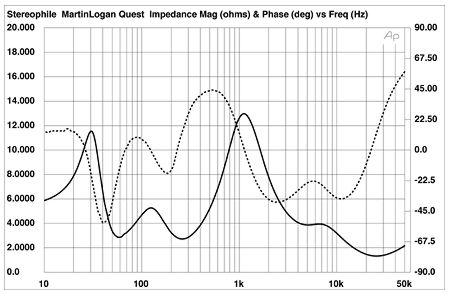
Fig.1 MartinLogan Quest Z, electrical impedance (solid) and phase (dashed) with contour switches set to "flat." (2 ohms/vertical div.)
Fig.2 shows the individual responses of the woofer and panel with both controls set to "Flat." The woofer's trace was taken in the nearfield, while the panel trace is a composite of the nearfield response below 355Hz and the quasi-anechoic response at a distance of 45" on an axis level with the center of the panel. Unusually, the woofer seems to have a bandpass response centered higher than its electrical tuning frequency, in the 50–55Hz region. This will still result in reasonably good extension in-room. However, there will be a lack of upper-bass energy resulting from what appears to be a too-early low-pass woofer characteristic and a too-high panel high-pass characteristic. This presumably correlates with DO's listening impression that the speaker was "lean," overall.
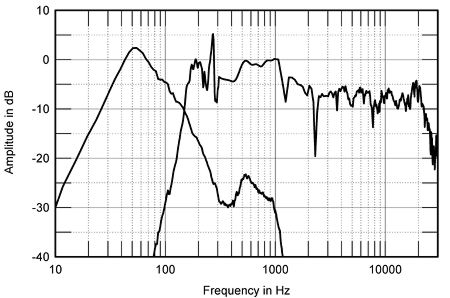
Fig.2 MartinLogan Quest Z, anechoic response of electrostatic driver halfway up panel at 45", averaged across 30 degrees horizontal window and corrected for microphone response, with the nearfield responses of the panel plotted below 350Hz and of woofer.
Turning to the panel, it's possible that the narrow peak at 275Hz is a nearfield measurement artifact (footnote 1). The sharp notches at 1.2 and 2.3kHz, too, are presumably due to interference effects at the close measuring distance, and would be inconsequential at a more typical listening distance. Note, however, the panel's steep high-pass rollout below 180Hz and a generally higher level in the midrange than in the treble. The response shelves down by some 10dB from 1kHz to 20kHz, which, on the face of things, will tend to make the speaker sound laid-back, with a rear-of-the-hall presentation. Remember that this, indeed, was what DO found.
In part, however, this measured response trend will be a function of the standard 45" microphone distance that I use. As explained in Martin Colloms's High Performance Loudspeakers textbook (footnote 2), the "proximity effect" comes into play when measuring physically large loudspeakers. With a panel loudspeaker, the necessary assumption that the measuring microphone is in the loudspeaker's far field becomes increasingly invalid with decreasing frequency. For measuring distances that are not very much larger than its panel dimensions, therefore, the response of the Quest will appear tilted down in the treble (above about 1kHz for a 45" distance).
To confirm this hypothesis, I performed a different kind of measurement. The one used to derive the fig.2 traces was performed by feeding the speaker under test what is called a "Maximum-Length Sequence" signal—which sounds like noise—calculating the speaker's impulse response from that signal, windowing out reflections of the impulse from the room boundaries, and calculating the amplitude response using the Fast Fourier Transform algorithm. My alternate technique was to leave the microphone in the same 45" position, feed the speaker with pink noise, and capture just over half a second's worth of the speaker's output. Applying the Fourier Transform to the digital data representing that noise gave the lower power spectrum shown in fig.3. Repeating the measurement with the microphone three times as far away, at 135", gave the upper trace shown in fig.3.
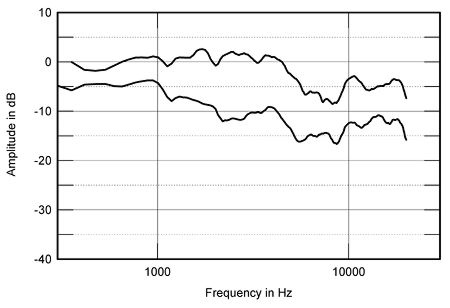
Fig.3 MartinLogan Quest Z, 1/5-octave–smoothed in-room responses at 45" (bottom) and at 135" (top).
The difference between these curves will be to some extent due to the different effects of the room at the two microphone positions, particularly in the midrange and below. (Both are 1/5-octave smoothed to minimize the effects of room resonances.) Nevertheless, as predicted, moving the microphone back to three times its normal distance brings up the Quest's mid-treble level by up to 6dB. Both curves, however, still shelve down above 4kHz, and the farther-away spectrum has significantly less top-octave energy.
I assume that such proximity-effect changes apply to the ear as much as they do to a microphone. If you do listen to the Quests in a small room, therefore, setting the speakers' presence switches to "+2dB" will add a mild presence-region hump to the on-axis response (fig.4), exactly as specified, which will slightly counteract the proximity effect.
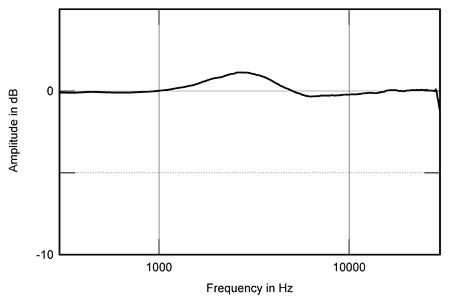
Fig.4 MartinLogan Quest Z, effect of presence control, assuming flat on-axis response.
Turning to dispersion, fig.5 shows the manner in which the Quest's response changes as the listener moves to the speaker's side. (Just the changes are shown, which means that the on-axis response is represented as a straight line.) The entire treble region stays in balance up to 60 degrees to the speaker's side, but increasingly shelves down past the 15 degrees angle. At 15 degrees laterally off-axis—the limits of the speaker's specified 30 degrees dispersion window—there is a little more high-treble energy and a little less presence energy than directly on-axis. The way in which the Quest's balance changes for differences in listener height is shown in fig.6. Although the treble only changes in a minor way as long as the listener's ears are between 36" and 63" from the ground, a suckout appears in the midrange for listeners who are significantly above or below the center-point of the panel, which is a high 48" from the floor.
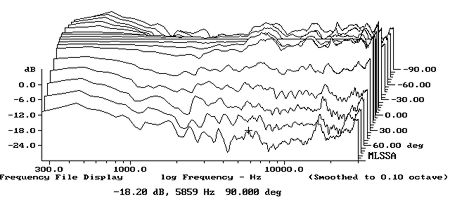
Fig.5 MartinLogan Quest Z, lateral response family at 45", normalized to response on mid-panel axis, from back to front: differences in response 90–5 degrees off-axis, reference response, differences in response 5–90 degrees off-axis.
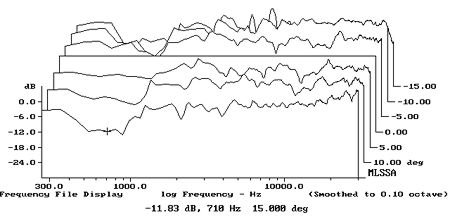
Fig.6 MartinLogan Quest Z, vertical response family at 45", normalized to response on mid-panel axis, from back to front: differences in response 15–5 degrees above axis, reference response, differences in response 5–15 degrees below axis.
In the time domain, the Quest's impulse response (fig.7) has a good time-coherent shape, but its tail is confused by ringing at both high and low frequencies. The step response calculated from this impulse (fig.8) has a good right-triangle shape, but, again, with low-frequency ringing very noticeable. (Although the woofer is connected with the same acoustic polarity as the panel, its passband is too low in frequency for its output to be visible in this 30kHz-bandwidth graph.)
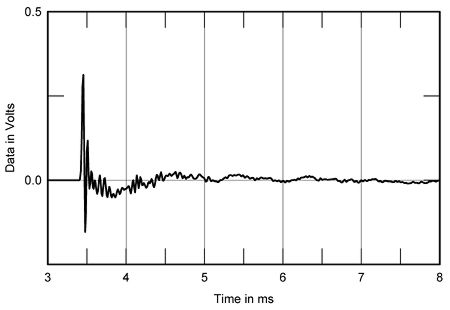
Fig.7 MartinLogan Quest Z, impulse response on mid-panel axis at 45" (5ms time window, 30kHz bandwidth).
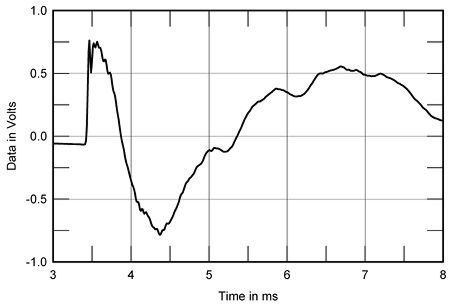
Fig.8 MartinLogan Quest Z, step response on mid-panel axis at 45" (5ms time window, 30kHz bandwidth).
Finally, the "waterfall" (or cumulative spectral-decay) plot calculated from the impulse response (fig.9) is typical of a panel speaker in that it shows a multitude of overhang problems in the treble, as well as some serious resonant modes at 1065Hz and 2220Hz.
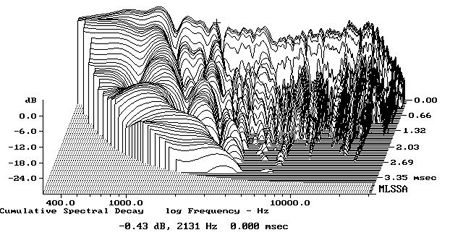
Fig.9 MartinLogan Quest Z, cumulative spectral-decay plot at 45" (0.15ms risetime).
How audible will these problems be? That is the $64,000 question, not just for the Quest but for all panel speakers, all of which tend to produce messy-looking waterfall plots. A large, uniformly driven, low-mass diaphragm seems to exhibit chaotic behavior; ie, adjacent small sections of the diaphragm don't move identically. In effect, while the diaphragm's average position moves uniformly in response to the driving force, there will always be small areas which move more than the average and others that move less, giving rise to hashy-looking waterfall plots. The ear, in these instances, must be the arbiter, such behavior having to be put against the absence of enclosure resonances and the better surface-loudness (or intensity) match with real sound sources. Certainly DO was mightily impressed with the overall sound of the Quest, which suggests that fig.9 is unduly pessimistic.—John Atkinson
Footnote 1: I suspect that it is due to the local "drumhead resonance" of the panel segment. As the panel is divided into many different-area segments, the resonance of each will be different, resulting in a much lower Q for the speaker as a whole.—John AtkinsonFootnote 2: Fourth Edition, pp.148-150, published by Halsted Press, a division of John Wiley & Sons. Available from Old Colony Sound Lab Book Service, P.O. Box 243, Peterborough, NH 03458-0243. Website.—John Atkinson


![]()
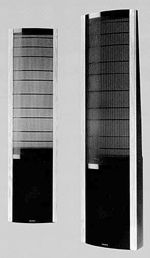 Looking at the progression from Aerius to Quest, a definite trend is apparent. First, the woofer increases in size, as does the electrostatic panel's radiating area. Second, the crossover point is approximately halved each step of the way, from 500Hz for the Aerius, to 250Hz for the Sequel, and 125Hz for the Quest. Third, the price increases by about a thousand dollars for each step upward in size.
Looking at the progression from Aerius to Quest, a definite trend is apparent. First, the woofer increases in size, as does the electrostatic panel's radiating area. Second, the crossover point is approximately halved each step of the way, from 500Hz for the Aerius, to 250Hz for the Sequel, and 125Hz for the Quest. Third, the price increases by about a thousand dollars for each step upward in size.







